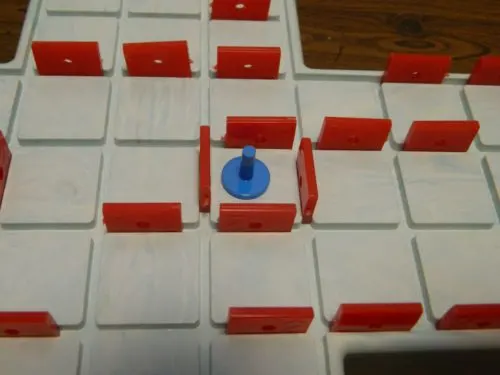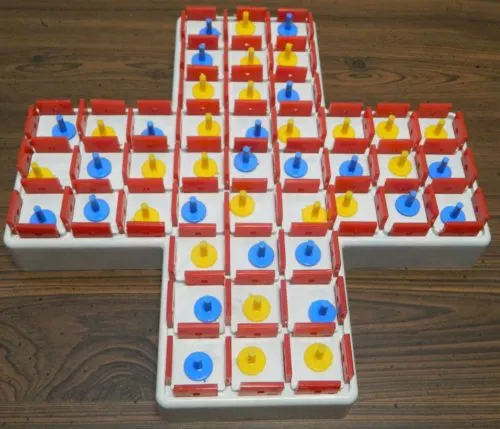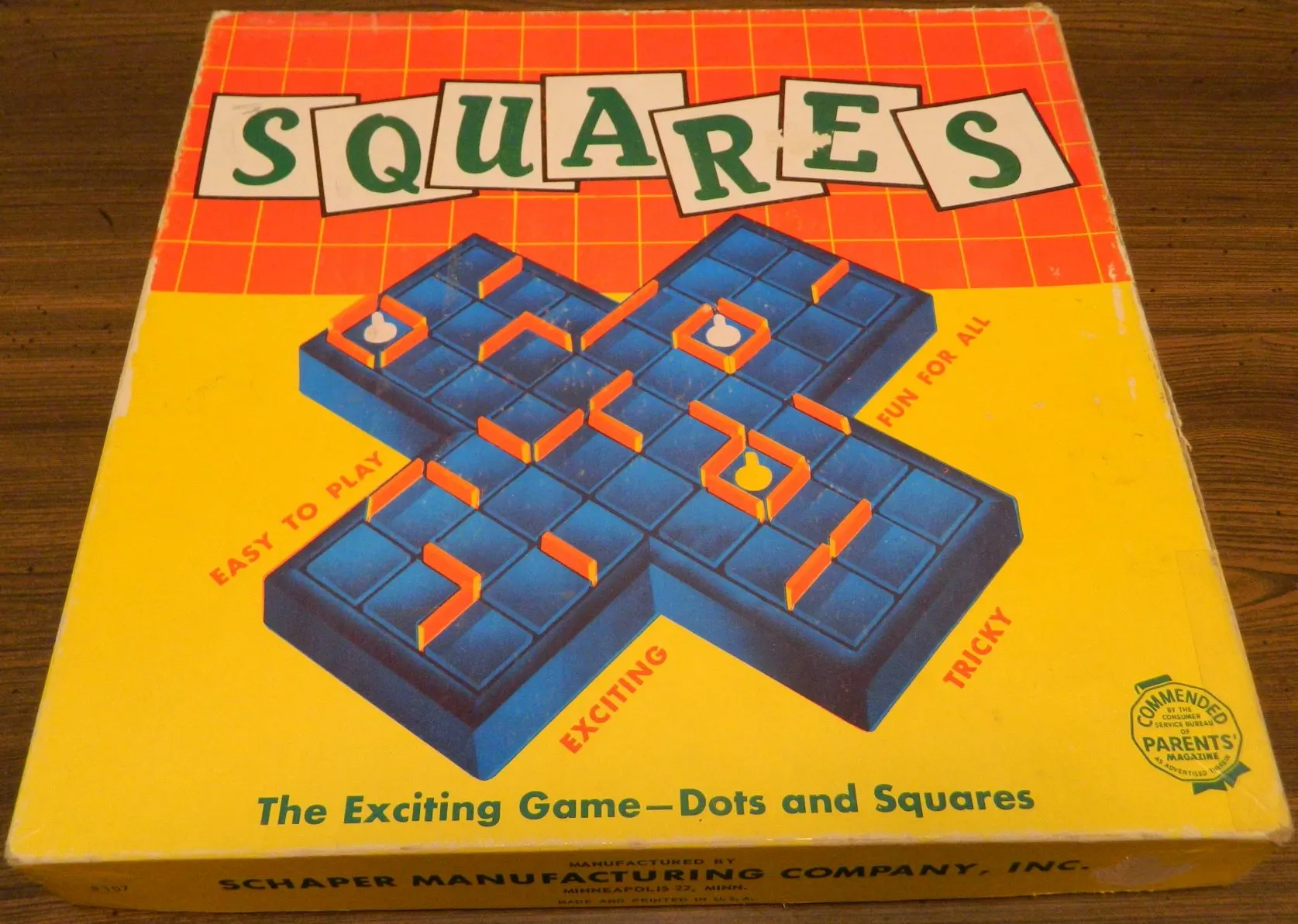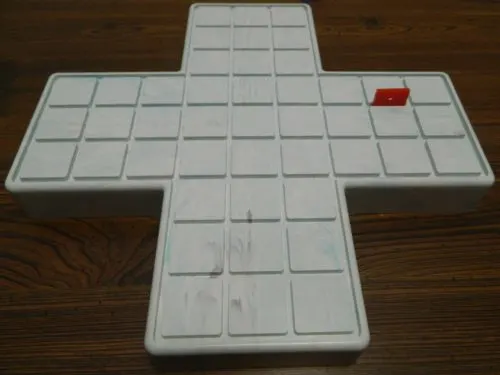Originally created back in the 19th century by the French mathematician Édouard Lucas, Dot and Boxes has been a popular public domain game for many years. The game goes by a number of different names throughout the world, and there are various layouts and small tweaks to the gameboard. Most people have probably played the game at least once in their lives. Basically the game consists of drawing a bunch of dots on a piece of paper with players taking turns drawing lines between them. The objective of the game is to complete more squares than the other player. I remember playing the game quite a bit as a kid, mostly on car trips. With the game being a public domain game, there have been a number of board game publishers over the years that have made a physical version of the game. I am looking at one of those today, The Game of Squares made by Schaper. The Game of Squares is a solid abstract game that is both easy to play and yet has a decent amount of hidden strategy, but it doesn’t really justify being made into a physical board game.
How to Play The Game of Squares
Setup
- If there are four players, alternating players will be teammates.
- Each player/team chooses one of the colors of counters. They will take all of the counters of that color.
- One of the players is chosen to start the game.
Playing the Game
On a player’s turn they will insert one of the fences into one of the unoccupied slots in the board. Play will then pass to the other player/team.
When a player places a fence that completes a square, they will place one of their colored counters inside the square indicating that they own that square. The player will then get to place another fence. If this creates another square they will get to take another turn. This continues until they place a fence that doesn’t complete a square.

The blue player/team has finished off one of the squares. They will place their colored peg on the space and will get to place another wall.
End of Game
The game ends when all of the squares have been filled in. The player/team that has claimed the most squares wins the game.

All of the squares have been filled in. Blue claimed 22 squares and yellow claimed 23 squares. As yellow claimed more squares, they have won the game.
My Thoughts on The Game of Squares
As The Game of Squares is a public domain game that most people have played at some point in their lives, most people probably already have a pretty good idea of whether they will enjoy it. Basically if you have ever played Dots and Boxes or one of the many other names that the game goes by, your experience will be exactly the same with The Game of Squares. The only thing that slightly differentiates it from the rest of the games is the x/cross board that is included with the game. Most versions of the game utilize a square or rectangular layout.
I would say that The Game of Squares’ greatest strength is the fact that it is really easy to play. Basically just choose a position where you want to place a wall. That is all there is to the game. The few people who have never played a version of the game before can probably learn it within a minute or two. The game has been played by children for a long time for a reason. The game doesn’t have a recommended age, but I see no reason children as young as five to seven couldn’t play The Game of Squares. The simplicity also makes it a game that anyone can play even those who rarely play board games.
Because of the simplicity The Game of Squares also plays pretty quickly. Your options on any given turn are pretty obvious. I would guess most games will only take 10-20 minutes. The one caveat to this is if one or more of the players suffer from analysis paralysis. Especially early in the game there are actually a lot of different options. If players are going to analyze every option The Game of Squares is going to take a long time, and it will likely ruin the game. I don’t really see anyone taking the game that serious though. You should take enough time to make sure that you aren’t making a mistake that will help the other player, but beyond that you shouldn’t overthink your choices.
Speaking of strategy this is the one area where most people’s thoughts on the game diverge. Some people think the game is completely random, while others actually think there is quite a bit of strategy to the game. I think this difference of opinion comes from the fact that The Game of Squares is like Chess, Checkers, and many other abstract strategy games where what you get out of the game depends on how much you play it.
Most beginners aren’t going to think that there is a lot of strategy to the game. I personally would consider myself a beginner as you likely will have to play the game quite a bit before you fully grasp how you are supposed to play it. On the most basic level you don’t want to add the third wall to any of the squares on the board. You want to either trick or force the other player into placing the third wall so you can then claim the square. To begin the game you don’t really know how things are going to turn out so you pretty much just randomly select where to place walls. This ultimately leads to sections being created on the board where once the third wall is placed a player can claim multiple squares in a row. Ultimately the goal of the game is to force the other player/team to place that third wall which lets you claim all of the squares in that section. Unless one player makes a mistake, it feels kind of random who will ultimately end up getting to take these large groups of squares. This is the main reason why a lot of people think the game doesn’t have all that much strategy and relies on a lot of luck.
As I mentioned earlier though, The Game of Squares is a game that begins to open up the more you play it. If you put in the time you start to realize that there is actually more strategy to the game than you would initially think. There are actually several different levels of strategy to the game as well as different approaches which improve your chances of winning the game. There have actually been whole books written about the strategy behind the game. This is not all that surprisingly since the game was made by a mathematician after all. If you are willing to put in the time, the better player will likely win most of the time.
At the end of the day The Game of Squares is a lot like your typical abstract strategy game. The game has absolutely no theme and thus it relies entirely on the gameplay. To do well in the game you have to think several turns in advance so you don’t back yourself into a corner. I personally am not the biggest fan of abstract strategy games. I don’t mind the genre, but I wouldn’t consider it one of my favorites either. That said I found The Game of Squares to be a solid but unspectacular game. I had fun playing the game, but it isn’t something that I would play all that often. If you generally like abstract strategy games, I see no reason why you wouldn’t enjoy it as well. Those who don’t generally like abstract strategy games though probably won’t care for The Game of Squares either.
The Game of Squares is a solid game, but I have one huge issue with it. Basically the game has been a public domain game for a long time which has allowed board game publishers to make their own versions of the game without having to pay the original designer. I really don’t have a problem with publishers when they do this as the games are usually pretty cheap and they sometimes make the game easier to play. In the case of The Game of Squares though, making a physical version of the game just makes the game harder to play. The game was originally designed to be played with a pencil/pen and paper. There really wasn’t any reason to make a physical version of the game. Because of this I don’t really see a reason to pick up The Game of Squares unless you can find it for really cheap as you can just use a piece of paper and basically get the same enjoyment out of the game.
Even though the components aren’t particularly necessary, I wanted to talk about them quickly. For this review I used the version made by Schaper. The game doesn’t have a copyright date, but I would guess that it was made in the 1960s or even earlier. Basically the game comes with the gameboard, walls, and markers to indicate who completed a square. The game utilizes a x/cross board layout. The component quality is pretty typical plastic from its era and thus it is pretty durable. It is somewhat nice to have a 3D representation of the board, but inserting the walls wastes more time than it should. I personally would just play the game with paper and pencil/pen, but I wouldn’t say that the components are bad if you are looking for a physical version of the game.
Should You Buy The Game of Squares?
Outside of using a different name as well as slightly tweaking the shape of the gameboard, The Game of Squares is basically the classic public domain abstract strategy game Dots and Boxes. Basically players take turns placing walls trying to finish off squares. Anyone who has played the pen and paper game knows exactly what to expect from the game. The game’s greatest strength is that it is so easy to play that it can be taught in about a minute. The game is accessible enough that anyone can play it. Because of the game’s simplicity a lot of people don’t think there is much strategy to The Game of Squares which is true to a point to beginner players as it can feel kind of random without a player making a big mistake. If you play the game a lot though, there is actually a decent amount of strategy to the game. The biggest problem with The Game of Squares though is that there really was no reason to make a physical copy of the game as you could easily play the game with just paper and a pen/pencil.
My recommendation for The Game of Squares depends on your opinion of abstract strategy games and the overall premise. If you don’t really care for either, I don’t see you enjoying the game. If you like both though, I think you will enjoy The Game of Squares. The problem is that since you can just play the game on a piece of paper, I would only recommend picking up the physical game if you can get a really good deal on it.
Buy The Game of Squares online: Amazon, eBay
. Any purchases made through these links (including other products) help keep Geeky Hobbies running. Thank you for your support.


